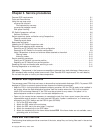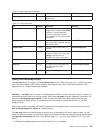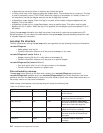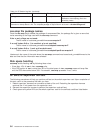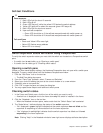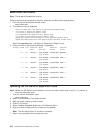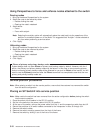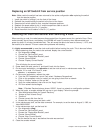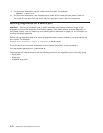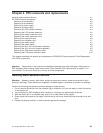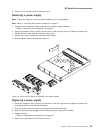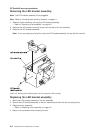
Removing and restoring switch resources
This procedure can be performed to allow customer to use a switch feature while extended service actions
are performed on an individual frame of a multi-frame system with the switch feature.
DO NOT PERFORM this procedure unless the required service operation will take the switch out of the
switch configuration for a minimum of two hours (for example, a part must be ordered or a switch or frame
must be repeatedly powered on/off) and/or the customer specifically requests it.
Care should be taken to understand the consequences on any partitions that might be sharing switch
resources. See “Using Perspectives to fence and unfence nodes attached to the switch” on page 3-10.
Attention: This procedure is intended to allow the customer to use the switch feature during extended
repair action. The customer must stop all parallel jobs prior to starting the repair. Once the repair is
complete, the customer must stop all parallel jobs again to reconfigure the switch to include the resource
again. If the service action is expected to be complete in a short period of time (for example, two hours or
less), this additional interruption of all parallel jobs will probably cost the customer more time than was
saved by use of the switch feature during that short period.
Removing an SP Switch2 from the active configuration
1. Identify the switch which is to be removed from the active configuration (see
RS/6000 SP: System
Service Guide
).
2. If the primary processor node (usually in Frame 1) is connected to the switch identified in step
1, the customer must select an available processor node to be the new primary processor node. The
primary node is set by the Eprimary command. Refer to
Parallel System Support Programs for AIX:
Administration Guide
(SA22-7348) for more information.
3. Have customer stop all current parallel jobs and suspend all parallel jobs on the job queue.
4. Put circuit breaker at the rear of switch assembly in the Off (‘0’) position.
5. The customer can re-initialize the switch using the Estart command. The frame and processor nodes
which were removed in this procedure will appear in the out.top file with error messages; however, the
remainder of the switch resources are now available for customer use.
6. If switch re-initialization was successful, the customer can start running parallel jobs again.
7. Return to MAPs to continue service action(s).
Restoring an SP Switch2 to the active configuration
1. Identify the switch to be restored to the active configuration.
2. Have customer stop all current parallel jobs and suspend all parallel jobs on the job queue.
3. Make sure that the circuit breaker at the rear of the switch is in the Off (‘0’) position.
4. Connect all cables to the switch. Pay attention to the labels on the cables.
5. Put the circuit breaker at the rear of the switch in the On (‘1’) position.
6. If the primary processor node was changed during the isolation procedure, the customer can change
the primary processor node back to the original selection; however, this is NOT required. The primary
node is set by the Eprimary command. Refer to
Parallel System Support Programs for AIX:
Administration Guide
(SA22-7348) for more information.
7. The customer can re-initialize the switch using the Estart command. Cables connected to the switch
assembly and processor nodes which were restored in this procedure should appear in the out.top file
without any error messages.
8. If switch re-initialization was successful, the customer can start running parallel jobs again.
9. Return to MAPs to continue service actions.
Chapter 3. Service procedures 3-9



